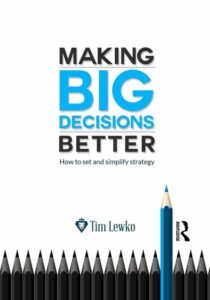Making Big Decisions Better
All organizations are faced with decisions. What to focus on, what to invest in, how to get to there from here are all common questions when approaching strategy.
I’ve read many books on strategy. There are many that are theoretical. I enjoy them and think about the implications. But there are a few that are actionable. As a CEO, I can use aspects of them immediately. That’s what I found when I read Tim Lewko’s new book, Making Big Decisions Better: How to Set and Simplify Business Strategy. Tim Lewko is the CEO of Thinking Dimensions Group, and his book goes right to the core of setting strategy that you can implement immediately.
I followed up with him to discuss his new book and his strategic work.
Develop a Common Definition of Strategy
Why is it problematic that most of us don’t share a common definition of “strategy”?
Not having a common definition of strategy creates all the problems CEOs, executives, managers and people who want to make their mark are trying to avoid in the critical areas of:
Purpose
Growth
Profit
What are some of the common misconceptions about strategy?
The list could be quite long but I will share the top three that trip up firms in setting a quality strategy—and that are easy to fix if the CEO and leadership chooses to. They are:
- EUREKA – It’s a magical idea that just comes to you
- SINGULAR – One person holds the key to the great idea
- BYPASS SWEAT EQUITY – Outsiders can tell you the answer and it should work
Be Wary of Outsourcing Strategy
Why is it often problematic to “outsource strategy” work?
There are many large successful firms that come and provide the “answer” that shows up as a long set of PowerPoint slides – and this prescriptive approach is the choice for many CEOs. However, the approach which I practice is process based – where we bring a proven strategy system that “forces tough tradeoffs” and leaves them in a better place because they created the strategy and understand how to modify the choices as events fold. This process approach helps to avoid the problems associated with outsourcing strategy including:
- DEFAULT on sweat equity – missing out on working through, understanding and deciding the key things that matter from EXTERNAL and INTERNAL standpoints
- TOLD WHAT YOU ALREADY KNOW – in my experience, clients already know 85% of what’s holding the business back (outsiders may give you 60%) so why pay for what is already known?
- DELAY or DESTROY BUY-IN – if you outsource strategy, you have already short-changed your ability to implement the strategy – because you have side-stepped the most important people – your executive team and workforce who need to intimately understand the why behind the PRODUCT, MARKET and CAPABILITY choices that are being made. Sure, a great CEO communication or town hall helps to sell the outsourced strategy, but deep down those closest to the issues feel side-stepped – and it takes an awful lot of time to get them to buy in to something that is not theirs.
Have a Visible Process for Strategy
You outline four phases of the strategy process. Is there one phase that most executive teams struggle with more than others?
I would re-phrase the question – Does your company have a visible process for strategy? If not, that’s the first task – you need to get a recipe that allows you to appraise the outside, that helps you understand why you make tough choices, that links to plans, and that forces course corrections.
Without the understanding for WHY a process is important and needed as a common language, it’s unfair to answer where the greatest struggles occur.
However, if a company does have a strategy process, they will know the toughest struggle is not agreeing on the choice to pursue, but rather agreeing on the criteria—and the relative importance of the criteria—that drive decision making in the company.

What’s the AFC Matrix and how is it used?
Great question.
The Advantage – Future Capabilities Matrix or AFC is where the rubber meets the road, what boards can use to drive their “thumbs up / thumbs down” decision on strategies.
The AFC simply forces the questions and the answers to:
What is our advantage (why should customer pick us over the competition and pay a premium)? And if we are that good, what are the specific investments in people, equipment, technology (assets) that will cause us to have a predictable and sustainable return?
It’s really like an in-depth back-of-the-envelope reality check with an ROIC perspective. If you are going to grow the business and need this type of investment to deliver that growth, then you can articulate by PRODUCT and MARKET how your advantage will be funded and the return it will yield.
That aside, this is one of the core quality checks we have in our process to ensure no BS passes through. On the other hand, when it does pass the BS test, it immediately sets up the HOW or implementation priorities which seem to be so elusive in many companies.

Would you share some of the problems with strategic goal setting?
- They not strategic – because the people in the room grew up through an operation lens or excelling operationally
- They always end with ZEROS – meaning companies state a strategic goal as a financial number. Any seasoned executive will tell you financial targets are not strategic because numbers alone have no context — it’s the Product and Market choices and the capabilities selected that yield that “NUMBER.” We often hear that our strategic goal is to be number 1 in market share by 20XX. That’s not a strategic statement; it’s only hot air. The means to get there is really though hard and shrewd PRODUCT and MARKET choices relative to what’s happening EXTERNALLY.
- They have too many goals – more than 3 is TOO many.
4 Common Mistakes
 What are the most common mistakes you’ve seen leaders make when working on corporate strategy?
What are the most common mistakes you’ve seen leaders make when working on corporate strategy?
Again, there could be a longer list – but 4 stand out, are easily fixed, and cost nothing:
- They verbalize it rather than make it visible (convince vs involve)
- They see it as an event rather than a process (eureka vs evolution)
- They want to own it rather than have it owned by their people (decree vs engage)
- They want to believe strategy is time-bound (3-5 years qualifies as strategy) versus a framework that helps define the purpose and path of the organization – even though they acknowledge the dynamics and upheaval of their competitive environment.
For more information, see Making Big Decisions Better: How to Set and Simplify Business Strategy.

